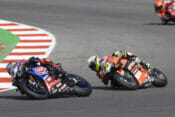Cycle News Archives
COLUMN
25 Years of The Yamaha YZF-R1
The year is 1998. Yamaha launches the first edition of the YZF-R1. The world’s press is gob smacked, and the company can’t keep up with demand. Waiting lists blow out to six months for salivating customers—and Yamaha’s rivals have been caught with their pants down.
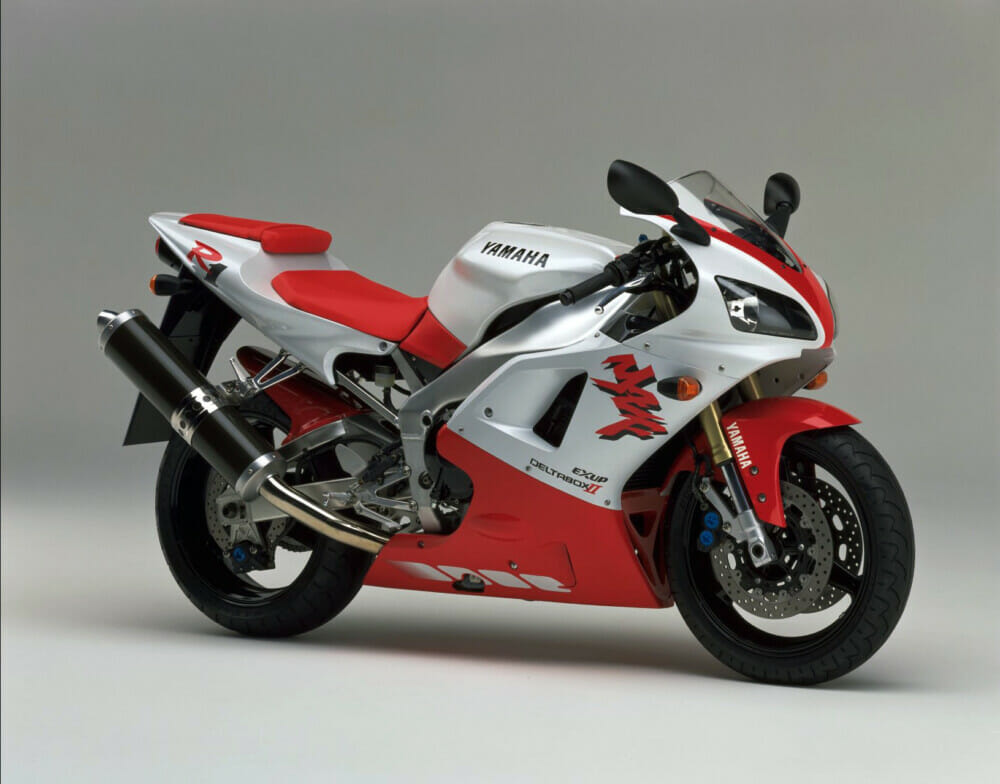
Photos Courtesy of Yamaha
The 1998 Yamaha YZF-R1 is the granddaddy of the modern Superbike. Until its release (and for some time after it), Superbikes were classified as 750cc four-cylinder machines and 1000cc twins. World Superbike would keep these rules until the end of 2002, but in reality, the world had moved on in 1998. The R1 saw to that. The R1 also saw the death of the ’90s liter-class hyperbike (an over-exaggerated term common at the time for anything bigger than a Superbike), which arguably began when Teo Baba released the mighty 1992 Honda CBR900RR Fireblade.
Sportbikes at the time were primarily designed as road bikes, not racers with lights. The R1 was the first to take this way of thinking and junk it. Comfort was reduced to the bare minimum in the name of pure speed. Even things like a handy trunk under the seat—like the Fireblade had—were regarded as unnecessary. Anything that didn’t need to be there was scrapped. The 998cc R1 was designed to be the lightest, shortest and most powerful machine ever created in the 1000cc class. It was designed to handle with the agility of the company’s YZF600 ThunderCat (then its leading Supersport 600 machine) but have power levels normally reserved for factory WSBK riders Scott Russell and Noriyuki Haga. A sports-tourer the R1 was not.
A Clean Sheet Of Paper
The mid-’90s was a bleak period for Superbike sales, and Yamaha realized that although the long-standing YZF750 was a good performer on track, the sales success didn’t reflect it. As such, designer Kunihiko Miwa was given a clean sheet of paper to build a new Supersport machine, right around the time the Yamaha YZF1000 ThunderAce was given a freshen-up in 1997.
The ThunderAce had always been a reliable performer for the Tuning Fork brand, and the 1997 version was indeed a fine machine. It had plenty of power from the five-valve, transverse four-cylinder engine that could trace its heritage to the FZR1000 of 1989, with a well-balanced chassis and good ergonomics—but it still belonged in the Suzuki GSX-R1100 weight class and would hardly do as a racer with lights.
That being the case, Miwa-san took the basic YZF1000 engine and pulled it to pieces. The R1’s engine was still to retain the company’s sacred five-valve cylinder-head, but that’s about where the similarities between it and the ThunderAce ended. Miwa-san concluded that the traditional engine layout where the crankshaft, driveshaft (countershaft sprocket) and mainshaft were all in a line represented a drastic waste of space, so he came up with the “3-axis” design, where the main shaft was offset and positioned above the crank and countershaft sprocket, closer to the crank. This new design was soon adopted by the industry and is now the only way to go if you want to build a serious across-the-frame four-cylinder Superbike. The new design also meant the clutch could now be mounted higher, with the cylinders and crankcase cast as a complete unit. This also allowed Miwa-san to turf the traditional cast iron cylinder liners, the bores now treated to the Yamaha-patented electro-deposited low-friction ceramic coating. Even the layout for the oil filter and cooler was redesigned, sitting side-by-side at the front of the block rather than being stacked, as per conventional thinking. This gave Miwa-san the ability to mount the headers of the four-into-one exhaust system—featuring a revised version of the EXUP (Exhaust Ultimate Powervalve) system—closer to the engine, giving him more clearance for the front wheel and thus making the front even more compact.
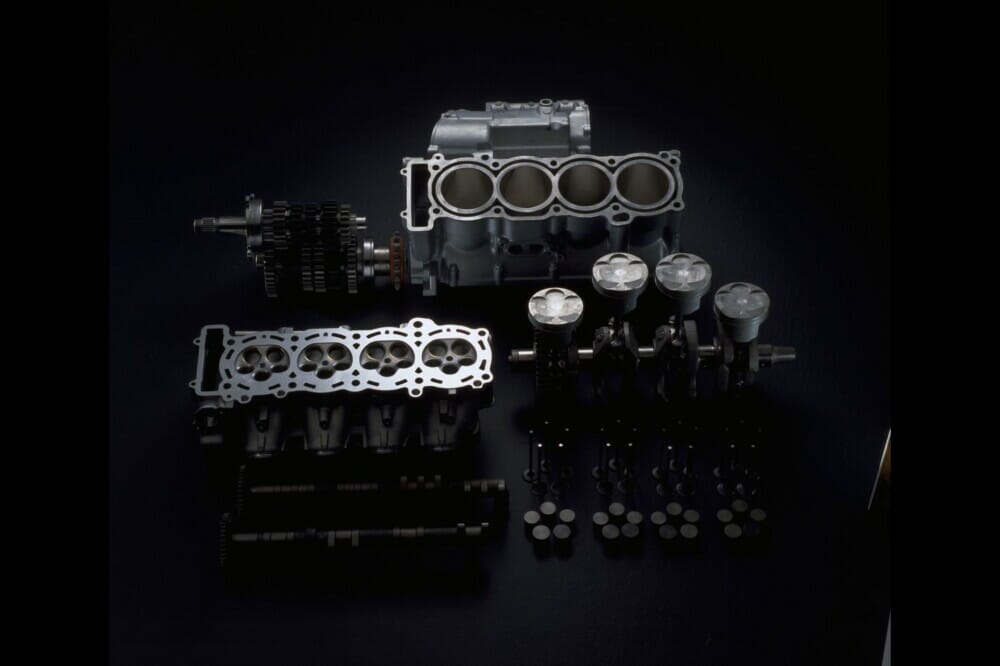
The difference between the R1 powerplant and that of the ThunderAce was not just external size. Internally they may have shared the five-valve head, but the R1’s inlet ports were smaller and inside the head sat smaller valves at a steeper angle, all in the name of increasing the gas flow.
The blocks were different too, with the R1’s bore and stroke measuring 74 x 58mm compared to the shorter stroke figures of 75.5 x 56mm for the ThunderAce. Below deck, the crankshaft came in for the weight-loss treatment. Yamaha engineers managed to shave an impressive 22 percent off the reciprocating mass of the crank, which was a major factor in the R1’s impressive throttle pick-up. Swinging off the crank were new con-rods with lightweight forged-aluminum pistons.
Even though the two engines shared a claimed torque figure of 78 lb-ft, the R1, which carried an 11.8:1 compression ratio to the ThunderAce’s 12.0:1, made that figure 1500 rpm lower at 8500 rpm. It also had an extra five horsepower, with a claimed 148 horsepower at 10,000 rpm. Those were serious figures for 1998. The Honda Fireblade, which for 1998 had grown to a 919cc engine, claimed power and torque figures of 130 horsepower at 10,500 rpm/67 lb-ft at 8500 rpm. And Kawasaki’s ZX-9R, which was also revised for the 1998 model year, produced 143 horsepower at 11,000 rpm and 74 lb-ft at 9000 rpm.
These were still the days before fuel injection became commonplace in production sportbikes, and rather than get a jump on the pack by fitting EFI, Yamaha instead chose to furnish its new weapon with 40mm BDSR Mikuni carbs, which were 30mm narrower than the ThuderAce’s 38mm units. The R1 ran a throttle position sensor, which was also linked to the CDI unit, gear position indicator and the EXUP valve, and programmed to increase the available torque from 4-8000 rpm.
Getting all that grunt to the tire was a new six-speed gearbox, replacing the five-speeder in the ThunderAce. This new gearbox became one of the few weak points in the 1998 R1’s armor, but thankfully Yamaha engineers were wise to this and for 1999—even though the model was only slated to have a paint scheme update—they fitted a redesigned gear change linkage and increased gear change shaft length to stop it from popping out of gear, particularly second gear. The 1998 R1 was also the subject of a worldwide recall, with several cases of the clutch-driven gear drive plates breaking, causing the engine to lock up.
But regardless of the faults, whatever angle you looked at the new engine it was a class ahead of everything in 1998. The design brief of smaller, lighter, faster was certainly met. The new engine was 81mm shorter front-to-back than the ThunderAce, and 20.9mm shorter top-to-bottom. However, unlike the engine, the chassis had no platform for modification. It was to be all-new—shorter and lighter, with racier geometry than anything with a headlight that came before it.
Yamaha claimed the new bike weighed 390 pounds dry, which, when you add a tank of fuel, would put it close to the 440-pound mark. With the engine being so small, Miwa-san could focus much more on mass centralization than ever before. The engine was a fully stressed member of the chassis, which helped add to the rigidity of the whole package. The new chassis, labeled the Deltabox II, was 2.8 pounds lighter than the ThunderAce, and with a 22.9-inch swingarm gave a final wheelbase of 54.9-inches, a massive 2.7-inches shorter than the ThunderAce.
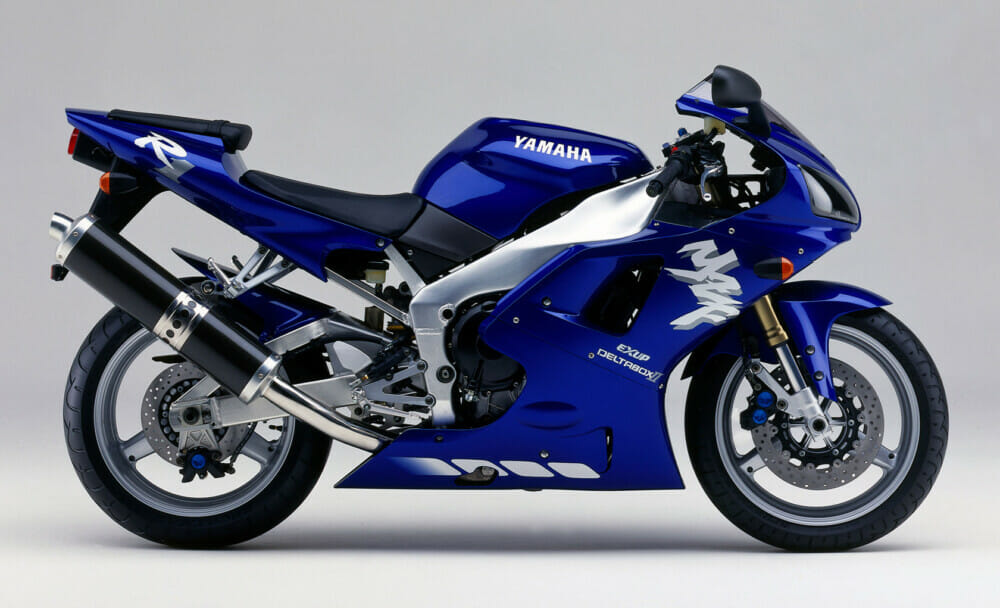
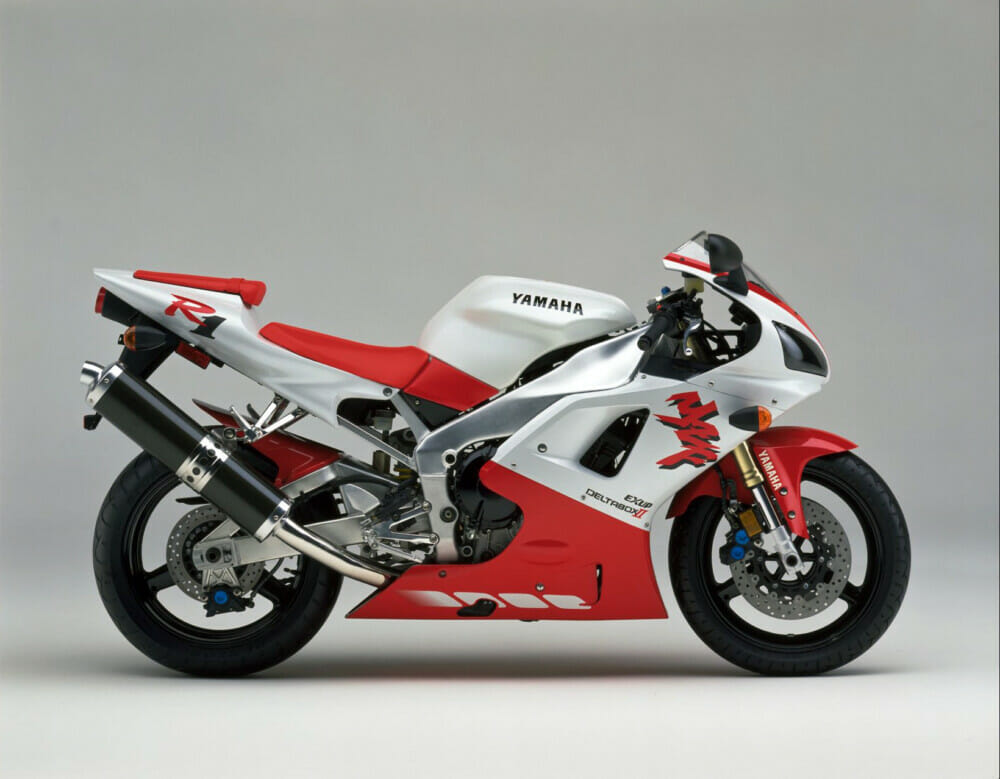
Up And Away
The Deltabox II chassis was comprised of cast aluminum in a twin-spar layout. Miwa-san got as close to the ideal 50/50 weight distribution mark, and even went to the trouble of saving about 47 percent off the overall weight of the handlebars! The tank incorporated lap welding to allow it to sit further into the top of the chassis, and the fairing was fitted with race-style quick-release fasteners to enable the rider to whip it off quickly if needed.
When it came to the suspension, Miwa-san opted for 41mm upside-down, fully adjustable forks, offering 5.3 inches of travel. This was around 0.5 inches up on the rest of the competition, with Miwa-san noting that the extra travel reduced the fork’s tendency to top-out under hard acceleration.
The rear suspension duties were taken care off by a fully adjustable Bilstein monoshock using Yamaha’s Monocross linkage system. Significantly for future collectors, the suspension is completely rebuildable (the original Fireblade’s suspension is not)—good news especially when you consider how hard some 1998 R1’s have been hammered over the years.
Even though the R1 was a technically superior machine to anything on the market at the time, it also changed the way people styled sportbikes. Just as the Honda CBR900RR had in 1992, and the Ducati 916 did likewise in 1994, the R1 made people stop and ask, “what the hell is that?” Design in the ’90s, particularly after the 916 appeared, changed very little until after the R1 came to dealer floors. Indeed, Honda went right back to the drawing board and released the dramatically, aggressively restyled Fireblade 929 of the year 2000, and Suzuki immediately began drawing up the bike that would ultimately displace the R1 at the top of the sportbike tree, the Suzuki GSX-R1000 of 2001. It took Kawasaki until 2004, with the first edition of the ZX-10R, before they even began to get a look in.
Such was the impact of the first R1 it is still revered as one of the most important sports motorcycles ever released. Ask many non-motorcycling people and they may not know what a ZX-10R, or a CBR1000RR is, but you can almost bet they have heard of an R1. That’s because the R1 simply blasted the competition to bits in 1998 to 2001. It rightfully earned a reputation as a fearsome machine, designed for experts and it no doubt caused its fair share of broken bones and bodies as lesser mortals tried to take the R1 to its limits and got bitten. The 1998 Yamaha YZF-R1 is truly a machine that has earned its place in motorcycling history. CN
Click here to read the Archives Column in the Cycle News Digital Edition Magazine.
Subscribe to nearly 50 years of Cycle News Archive issues
